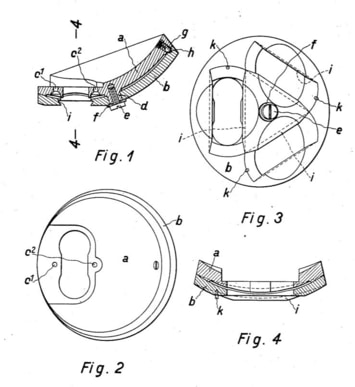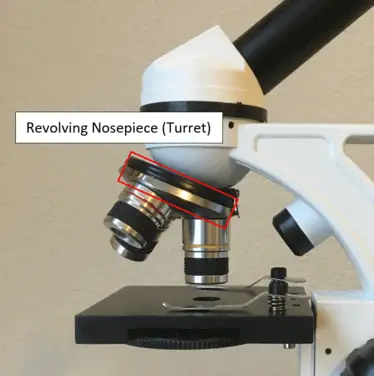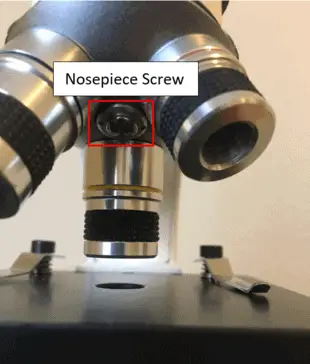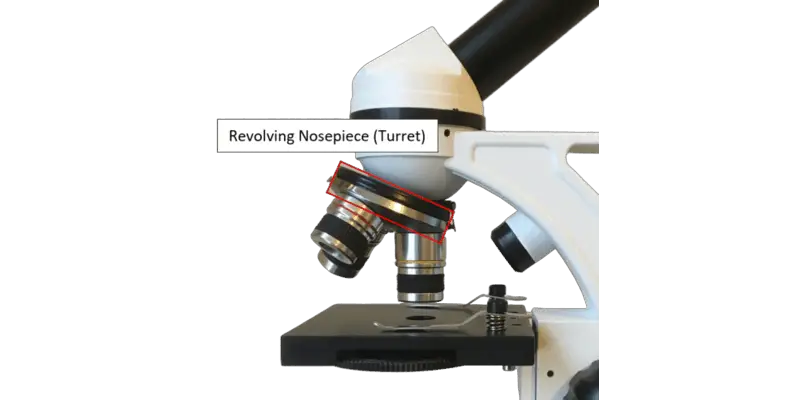The microscope nosepiece, also known as the revolving turret, sits below the head of the microscope and locks the objective lens into position over the stage aperture by rotating in either direction. The microscope nosepiece can house anywhere from 3 to 5 objectives depending on the type of microscope.
If you’ve ever seen or used a revolver you know the cylinder contains the bullets which are lined up with the barrel and fired by the firing pin. In any action movie with a revolver you see the person spinning the cylinder and locking it into place in preparation for firing the gun. The nosepiece plays a similar role for the microscope.
If you’re not sure what the objective is or what it does please check out Microscope Objective: The Eyes of the Microscope. In this article we will explore all the detail and nuance associated with integral part of the microscope.
Microscope Nosepiece Function
The main purpose of the revolving nosepiece of the microscope is to easily and systematically interchange the objective lenses. Objective lenses come in increasing magnifications and depending on the microscope, the nosepiece can hold anywhere from 3 to 5 objectives.
Sophisticated microscope nosepieces lock the objective lens into place which such precision that the objective stays in alignment and completely centered with the with the specimen. This precision eliminates the need to re-position a slide and reduces the time to focus.
The revolving nosepiece was patented in 1928 and in the patent application appealed to the time saving nature of the invention. You can see below that nosepiece of today has changed a little from the original design, but the basics are essentially the same.

Microscope Nosepiece Location
The revolving nosepiece is located at bottom of the head of a microscope on an upright microscope. The nosepiece is easily identifiable because it has a distinct disc shape and it will have the objective lenses screwed into it.
On an inverted microscope the nosepiece is located underneath the stage with the objectives pointed upward. The nosepiece on an inverted microscope works the same way as a standard microscope.

How to Use the Revolving Nosepiece
The revolving nosepiece revolves by grasping the objective along the etched grip section of the objective lens and rotating it either clockwise or counterclockwise depending on which objective you are trying to lock into position. Some larger microscopes have etched grip right on the revolving nosepiece so if the microscope you are using has the grip there you should use that to turn the nosepiece.
Before you begin using the microscope, ensure the lowest power objective is locked into place by listening for the auditory click sound. Once you find focus with a low power objective the next step is to rotate the nosepiece to the higher power objective. Then once you find focus again you will rotate the nosepiece again to the higher power objective and repeat this process until you reach the desired magnification.
My Microscope Nosepiece is Loose What Should I do?
There are times where I have found that my nosepiece has become loose and the rotating mechanism is not rotating in a controlled manner. If you find that you are experiencing this problem one thing to check is the nosepiece screw. If it’s too tight you can loosen a bit or if it’s too loose, which is normally the case, you can tighten it.

How to Remove an Objective From the Microscope Nosepiece
There are many reasons you would want to remove your objective lenses from the nosepiece but the most common is removing an objective to clean it. To remove an objective, you just twist the objective to the left just like a screw and unscrew it with your hand.
To put the objective back, it is sometimes easier to twist the objective left to find the threading and then begin twisting the objective lens to the left. Below is a demonstration that illustrates this.
Takeaways
The revolving nosepiece is a time saving and integral part to the working of a microscope. The nosepiece enables the microscope user to quickly change objective lens magnifications and while keeping the specimen centered. I hope this article has cleared up any ambiguity you may have had on this topic and now you’re ready to lock n’ load and start magnifying!

